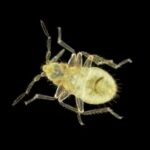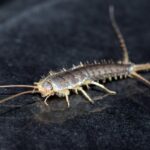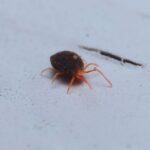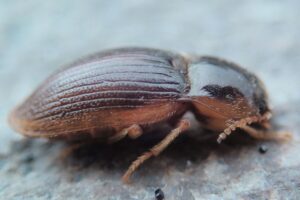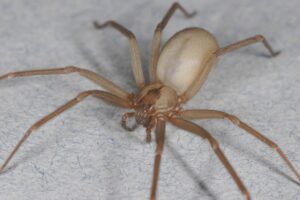Seeing tiny black bugs in the bathroom is scary! You might instantly freak out and feel gross as soon as you lay your eyes on them. Before you panic, however, you must know what they are. Most importantly, you must figure out how to get rid of them and prevent their presence in the future.
The tiny black bugs in your bathroom are small insects that often thrive in dark, damp, and moldy spaces. Most of the time, they do not carry diseases unless it is a cockroach.
Below is a table that shows some of these insects, as well as their appearance:
| Name | Physical Characteristics |
| Drain Flies | 1.5 to 5mm, black, tan, or light gray body with semi-transparent wings and covered with fuzzy hair |
| Booklice | Up to 2mm, black, brown, gray, or white soft body with slender antennae, large nose, winged or wingless |
| Earwigs | 5 to 25mm, pearly white and oval eggs, black to reddish-brown |
| Fungus Beetles | 5.5 to 7mm, black or red-orange body, red hood |
| Silverfish | 13 to 25mm, black, silver-gray oval, and elongated body, with antennae |
| Cockroach | 2 to 3mm when young, oval and flat body, six legs and a strong spine |
Read on to learn more about tiny black bugs in the bathroom, including their types and physical characteristics.
What Are the Tiny Black Bugs in the Bathroom?

Bugs are everywhere in your home. You will find tiny white bugs in the kitchen. At the same time, you will also see small black bugs thriving in your bathroom. In the case of the latter, below are some of the most common:
1. Drain Flies
Also called moth flies, filter flies, sink flies, and sewer gnats, drain flies (Psychodidae) are commonly found in the humid tropics. They congregate and mate in areas of the house with stagnant water and excessive moisture, making them a common problem in the bathroom. They breed in different places, especially in the part of a drain with a slimy film.
One thing that makes drain flies annoying is that they are often present in a group, making them a nuisance in the bathroom. Once the infestation gets serious, it can spread bacteria and clog pipes. Nonetheless, while they are filthy, they do not spread any significant diseases. In most cases, it is only a temporary problem.
Physical Characteristics
It is almost impossible to distinguish the appearance of drain flies from afar because they are tiny. In most instances, however, they have a tan or light gray body. Along with the semi-transparent wings, the body has long hairs that make them look fuzzy. As for the length, they usually range from 1.5 to 5mm.
Watch the short video below and find out more about drain flies:
2. Booklice
Also known as psocids, booklice are popular tiny black bugs that you will find in the bathroom, among other areas of the house. They do not survive in locations with high humidity. You will find them in highly moist places.
They thrive in warm and damp places. They are more common in dark areas. With this, in the bathroom, you will find them in hidden areas that light hardly reaches.
If they are present in large numbers in the bathroom, booklice can be a nuisance. Nonetheless, it is crucial to note that they do not bite nor spread any disease.
While they are harmless, they can cause distress, especially for someone who wants a spotless bathroom. Aside from physical presence, another way to tell that they are in the bathroom is when you see molds.
Physical Characteristics
A soft-bodied insect, booklice can grow at a length of up to 2mm. It has a long and slender antenna. As for the body, the color can vary, which can be brown, gray, or white. Some of them are wingless, but you can also find others with four wings. More so, they also have a large nose, which is known as clypeus.
3. Earwigs
Pincher bugs or earwigs are from the insect order known as Dermaptera. These are nocturnal insects, which you will often find in moist and small crevices during the day. At night, especially when there is no light, they go out of their hiding spot.
Because of this behavior, it is quite tricky to determine their presence and infestation in a bathroom unless you look closer.
Like the other tiny black bugs, earwigs are not a significant threat, especially if you are concerned about how they can impact your health. While they bite, such isn’t dangerous. It won’t hurt, although you can sometimes feel a slight pinch.
They also do not spread bacteria or any disease. Despite not having any apparent danger, they can still be annoying in the bathroom, so you must get rid of them.
Physical Characteristics
The length will range from 5 to 25mm, which will depend on the species. It is bigger than most bugs you will find in the bathroom, making them quite easy to spot. They have pearly white, small, and oval eggs.
From afar, they look black, but when you examine the insect closer, you will see that it has a reddish-brown body. It has two sets of wings, which let it fly.
The short video below talks more about earwigs:
4. Fungus Beetles
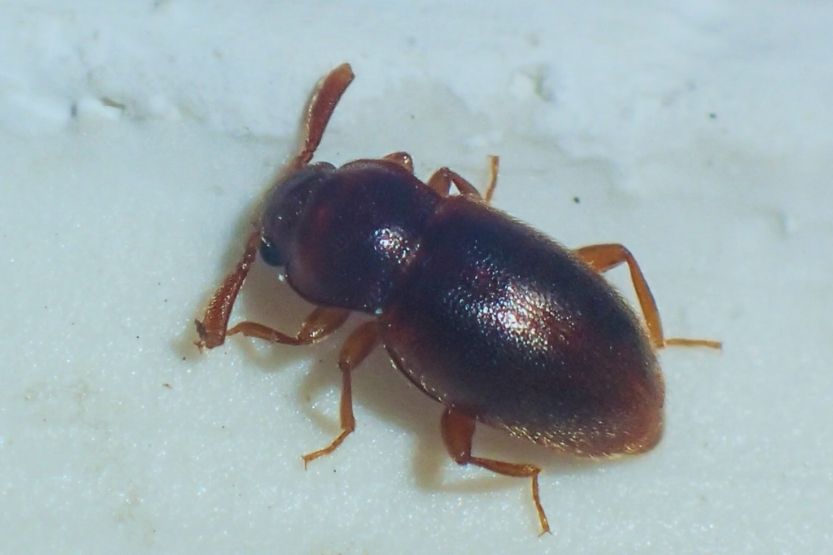
A fungus feeder and secondary pest, fungus beetles, are from the Tenebrionidae family and Coleoptera order. It is a scavenger, so you will commonly find it in the pantry, kitchen, or any other area of your house where there is food for them to feed on. At the same time, you can also find them in moldy and damp locations, including the bathroom.
It is common for these beetles to show up right after the rainy season. It develops from egg to adults rapidly, although such will largely depend on the temperature. If it is at least 75 degrees Fahrenheit, the beetles will complete their life cycle within 25 to 36 days. Meanwhile, in lower temperatures, they can have a life cycle of up to five months.
Physical Characteristics
While they are commonly black, it is not uncommon to see fungus beetles with a reddish-orange body. The length often ranges from 5.5 to 7mm. A red hood is also common in these tiny black bugs in the bathroom. You can find some of these bugs with distinct pimples or punctures in their body, but such are not easily apparent unless you look at them closely.
5. Silverfish
A small and primitive wingless insect, a silverfish is small and nocturnal, making it tricky to spot their presence in the bathroom. It moves like a fish, which is where it got its name. They often burrow in dark places, including bathroom cabinets. Another common characteristic is that they are fast movers, making it difficult for predators to catch them.
Like the other tiny black bugs in the bathroom, silverfish won’t hurt. It isn’t a carrier of diseases or other health problems. Nonetheless, depending on the extent of their infestation, they can destroy clothes and wallpapers.
Physical Characteristics
Also known as bristletails, silverfish has three long bristles in their body. While they are initially black, once they fully grow, their body turns silvery, and they move fast like a fish, which explains why they are called silverfish. They have an elongated and oval body, as well as antennae. As for the length, their body is usually 13 to 25 mm.
6. Cockroaches
There is perhaps nothing that is more notorious than cockroaches when it comes to bathroom pests. It is an ancient group of insects, which have been around for more than 350 million years.
Especially when they are flying, they can instantly freak anyone out. Not to mention, they are also unhygienic, making them a significant concern in many households.
During the day, cockroaches are not as visible. They are more active at night. They have collective decision-making, so there are probably others in the same area when you find one. Their saliva and feces can cause allergies. Plus, they can carry diseases, so you must work to eliminate them, not just in the bathroom.
Physical Characteristics
There are different types of cockroaches, and their appearance will differ from one type to another. It has an oval and flat body with long antennae. More so, they have a strong spine and six strong legs. They can grow up to 38 mm in length, so they are not exactly tiny. Nonetheless, when they are young, they can start at 2 to 3mm.
What Are Tiny Black Flying Bugs in My House?
Learn more about cockroaches and what makes them hard to kill in the video below:
Again, what are the tiny black bugs you see in your bathroom? The tiny black bugs you see in your bathroom, particularly around a tub’s drain or sink, are usually sewer or drain flies. They prosper in a dark, damp, and moldy environment and breed inside the drain. However, there’s nothing to worry about as they do not carry diseases, except for cockroaches.
Are Black and White Ladybugs Poisonous?
How to Get Rid of Tiny Black Bugs in the Bathroom

Do not panic when you see tiny black bugs in the house or bathroom. To eliminate them, here is a quick rundown of some of the best solutions:
1. Use a Natural Bug Repellant
Use a natural bug repellant to get rid of them. You can mix equal parts of white vinegar, sugar, and water in a bowl. Finish by adding up to 15 drops of dish soap. Put it in a spray bottle and directly apply to the bugs or areas they frequent.
2. Utilize Your Baking Soda
Baking soda is another natural cleaner that can do wonders. Mix half cup baking soda with half cup salt. Add one cup of vinegar and pour it on the drain. Leave it overnight, and when you wake up in the morning, rinse.
3. Make Use of Commercially Available Cleaners
If natural cleaners are ineffective, there are tons of commercially available cleaners. They are made of various chemicals. They work by unclogging the pipes and flushing the bugs that are hiding there.
4. Pour Hot Water Down the Drain
Pouring hot water down the drain will also do the trick, especially if you spot the problem early on.
Preventing the Presence of Bugs in the Bathroom
Prevention is better than cure, even when it comes to tiny black bugs in the bathroom. With this, below are some of the best things to do:
- Make sure that there is no source of stagnant water in the bathroom as it can be breeding grounds for tiny black bugs.
- Seal the crevices in the bathroom, especially those in the windows and ceiling. Otherwise, they will become potential entry points for bugs.
- Check out the plumbing and work with professionals if you are not familiar with the problem. Pipes can be causing leaks that encourage the presence of bugs.
- Keep your bathroom dry. Installing an exhaust fan is one of the easiest solutions. The more moist the area is, the higher is the likelihood that there will be tiny black bugs.
- Keep your bathroom clean. Any slime and debris accumulation will make the place more appealing to pests.
Conclusion – Tiny Black Bugs in the Bathroom
Many people will freak out when they see tiny little bugs. Nonetheless, in most instances, they do not hurt and won’t be a health problem. However, they can still be scary, especially when they are flying. The most common bugs that can thrive in the bathroom include drain flies, booklice, earwigs, fungus beetles, silverfish, and cockroaches.
To get rid of tiny little bugs in your bathroom, start by using natural solutions. Baking soda, vinegar, and warm water can help flush them out. Alternatively, you can also use commercial cleaners with strong chemicals if you want a quicker fix.
To prevent them from coming back, make sure to keep the place well-ventilated, seal potential entry points, and clean the bathroom often.
Related reading:

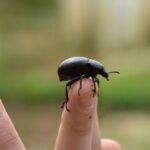
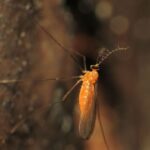
![Tiny Bugs in Bed [Not Bed Bugs] - What Are They? Tiny Bugs in Bed](https://homecarezen.com/wp-content/uploads/2022/01/tiny-bugs-in-bed-150x150.jpg)
